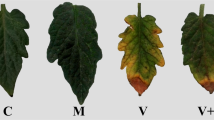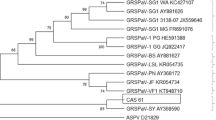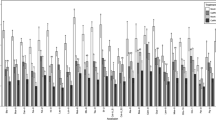Abstract
IN experiments which required the daily counting of TMV lesions on pinto bean leaves (Phaseolus vulgaris L.) for the purpose of determining specific rates of lesion-appearance, it was noted that those leaves which had the greatest final number of lesions produced a greater percentage of their lesions earlier. Since comparisons of rates of lesion development could be seriously affected by differences arising from this, an attempt was made to determine its cause and extent.
This is a preview of subscription content, access via your institution
Access options
Subscribe to this journal
Receive 51 print issues and online access
$199.00 per year
only $3.90 per issue
Buy this article
- Purchase on Springer Link
- Instant access to full article PDF
Prices may be subject to local taxes which are calculated during checkout
Similar content being viewed by others
References
Bald, J. G., Ann. App. Biol., 24, 33 (1937).
Wildman, S. G., The Viruses, edit. by Burnet, F. M., and Stanley, W. H., 2, 1 (Academic Press, New York, 1959).
Lauffer, M. A., and Price, W. C., Arch. Biochem., 8, 449 (1945).
Bryan, W. R., and Beard, J. W., J. Infectious Diseases, 66, 245 (1940).
Author information
Authors and Affiliations
Rights and permissions
About this article
Cite this article
PIACITELLI, J., SANTILLI, V. Relationship of Tobacco Mosaic Virus (TMV) Lesion Number and Concentration to the Rate of Lesion Production on Pinto Bean. Nature 191, 624–625 (1961). https://doi.org/10.1038/191624b0
Issue Date:
DOI: https://doi.org/10.1038/191624b0
Comments
By submitting a comment you agree to abide by our Terms and Community Guidelines. If you find something abusive or that does not comply with our terms or guidelines please flag it as inappropriate.



